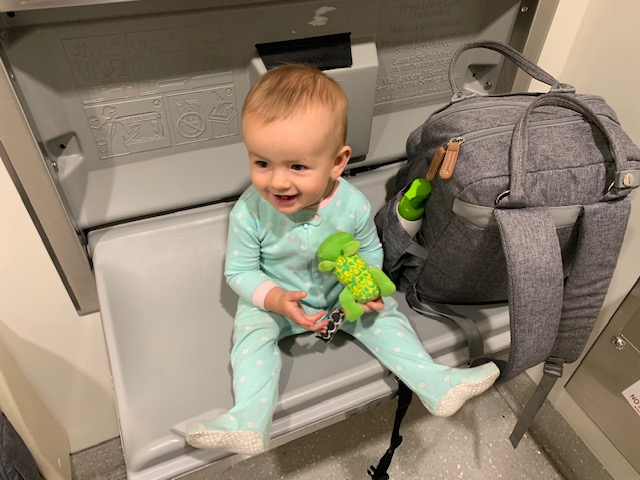9 Tips to Have a Natural Birth Experience at the Hospital

Are you a new mama wanting to have a natural birth but unable to do a home birth?
While giving birth in the comfort of your own home may sound like the ultimate natural birth experience, it may not be the best option for you if you are high-risk. Or maybe you feel like you will have more peace of mind being at the hospital. That’s completely understandable, especially if it’s your first! I’m a firm believer that a woman should give birth wherever they will be the most comfortable and able to have peace of mind. Without those two things, natural birth will be very difficult— even if you’re at home.
If the thought of being at home makes you anxious or scared, then being at the hospital may be what you need to be able to relax and have peace of mind. And trust me, you will have a better chance of having a natural birth if you are somewhere you feel comfortable!
But just because you have to give birth in the hospital does not mean you have to give up the idea of a natural birth experience!
(This post may contain affiliate links. You can read our full disclosure policy here.)
Why do I say a natural experience instead of just a natural birth?
Because a natural birth experience involves more than just giving birth naturally. The whole experience involves the early stages of labor and goes hours after the birth of your child.
There is an intimacy that comes with the whole experience of having your baby at home, from the beginning of labor to those precious moments after birth. Plus, you have ultimate control over the care of your baby from the second they are born.
So is that possible in the hospital?
Yes it is!
With a little preparation and forethought, it is definitely possible to have a natural birth experience at the hospital, and reap some of the benefits of a home birth (you can read my article about the benefits of a natural birth here.) Many of the following tips you can include in your birth plan. I used a template similar to this one for my birth plan and I loved it because it’s visual and very clear. I recommend posting it in your birthing room as soon as possible so it’s clearly visible to everyone and the doctors and nurses can easily refer to it.
But before you head to the hospital…
Labor at home as long as possible
Giving birth in the hospital does not mean you have to be at the hospital the whole time. In fact, they don’t WANT you there the whole time. If you go to the hospital too early, they will most likely send you home anyways. AT home you can
- have freedom of movement without being hooked up to IVs or monitors
- walk around your house or take a walk outside, which helps labor progress
- watch a movie (yes this is possible in the early stages of labor, and it can help you relax)
- labor in a warm bath
- create the mood you want to help you relax
- snack and drink freely
- have whoever you want there or don’t want there
- be in the comfort of your own home!
How do you know when it’s time to go to the hospital?
You are more likely to get to the hospital too soon than too late, especially if it’s your first. The Bradley Method book recommends heading to the hospital when your contractions are sixty seconds long and three minutes apart. Maybe four minutes apart if it’s your second, since things can move faster at that point.
Tips for laboring at the hospital…
1. Ask for a room with a window
This might seem funny, if not snooty, but if there was one thing I wish I had during my birth in the hospital it was natural light! I labored through the night and I had no point of reference as to the time of day it was, so it threw off my circadian rhythm. I was so tired, and I know that if the darkness could have been lifted with sunshine, it would have empowered me, knowing the night was over, and given me the second wind I needed.
It may not be possible, but you never know till you ask! It’s definitely worth a shot!
2. Bring comforts from home with you to set the mood
Bring your favorite pillow, birthing ball, essential oils, diffuser, or anything you would use at home to help you relax (just hold the wine… unless the hospital lets you, then bring the wine!) Actually, most hospitals may already have birthing balls you can use if you don’t want to bring your own.
They may not allow real candles, but even some LED candles can help create a relaxing atmosphere! These are my personal favorites because they look SO real and can make any spot feel warm and cozy— even a hospital room!
Have a birthing playlist? Bring a portable speaker and play it! Set the mood in the room that will help you not feel like you’re a rat in a laboratory waiting to be dissected (hospitals have a knack for making you feel that way.) Do what you need to do to create an atmosphere that makes you feel as relaxed and comfortable as possible.
3. Request freedom of movement over an IV drip
Being able to move freely during labor is SO important to keep you as comfortable as possible and to help labor to progress naturally! It’s one of the advantages of being at home, but you can request to have freedom of movement on your birth plan. An IV also makes it easier for them to give you medication, if needed. But if you are healthy and wanting a natural birth, you can request to not be hooked up to an IV.
4. Request to eat and drink (and bring your own snacks cuz hospital food sucks)
Eating during labor is not common practice in hospitals since they always want you ready for surgery. But being able to eat and drink is vital for restoring your energy and giving you the boost you need to get through labor and birth. To make up for it, they typically will put you on an IV drip to give you fluids, which is just another thing restricting you from freedom of movement and also makes it very difficult to go to the bathroom. Instead, have some prepacked high-protein and hydrating snacks ready to take with you to the hospital, like nitrate-free lunch meat, cheese sticks, watermelon, or grass-fed beef sticks.
Lily Nichols has an excellent homemade electrolyte drink recipe in her book Real Food for Pregnancy that I premade and had ready to go in the fridge to bring to the hospital. It’s simply
- coconut water
- juice of choice (I used orange)
- lemon
- a little sea salt
It’s delicious and free of all the sugars, preservatives, and colorings that’s in most sports drinks, and very hydrating!
Tips for after the baby is born…
5. Protect the “Golden Hour”
The first hour of your baby’s life is the most precious time for bonding. Protect that hour!! Delay any weighing or measuring until after these first impressions. Have the baby laid directly onto your chest for skin to skin contact and immediately let them breastfeed (if you intend to breastfeed.) It is amazing to watch this little infant instinctually know how to find and latch onto your breast. Let them smell you, feel you, hear you, and go from the warmth of your womb to the warmth of your arms. A mother’s chest is naturally two degrees warmer than the rest of her body, making it the perfect place to help a new baby regulate their own body temperature. Studies have shown this first hour of bonding time is critical for the growth and development of the baby.
Fortunately, respect for the golden hour is becoming more common practice in hospitals these days. But don’t assume! Unless there is a medical reason your baby needs to be taken away, that sacred hour should not be interrupted.
6. Have your partner cut the cord/catch the baby
Not all doctors or hospitals may allow your partner to catch the baby, but it’s worth asking! After all the hours your spouse spends observing you work this baby out, it is very rewarding for them to be able to have an active role in the delivery.
But even if they aren’t able to catch the baby (or you think they might faint lol) then request to have your spouse cut the cord! There’s no risk of dropping the baby and it’s still a way for them to be involved.
7. Delay cord clamping
Most hospitals in the United States do immediate cord clamping, which is about 10-15 seconds after birth. Delaying the cord clamping allows a continuous transfer of blood and nutrients from the placenta to the baby and can help prevent a blood transfusion or lack of oxygen in the baby. The book Natural Childbirth the Bradley Way says that cutting the cord too soon can deprive the newborn of one-quarter of his blood volume and can possibly cause anemia during the first year of life.
But how long should you delay the clamping?
Be aware that the hospital’s idea of delayed cord clamping might only be a few seconds longer than immediate clamping. According to an article on healthline.com, “The WHO recommends delaying one to three minutes before clamping. The ACOG recommends a delay of at least 30 to 60 seconds for healthy newborns.”
I say the longer the better! That same article states, “Waiting one minute allows your baby to receive about 80 milliliters (mL) of blood from the placenta. After three minutes, this increases to 100 mL.”
So if you want delayed cord clamping, be specific on your birth plan about HOW LONG you want them to delay.
8. Don’t let them bathe the baby
Bathing the baby within a couple hours after birth used to be standard practice, but not so much anymore as the benefits of not bathing them have come to light. Not only does it improve success in breastfeeding and temperature regulation, it also helps strengthen your baby’s budding immune system. When you give birth vaginally, you literally bathe your baby in good bacteria that soaks into their skin, mouth, eyes, and nose and begins a garden of microbes in their gut. It is the first gift you pass on to your baby to support their long-term health. Don’t let the good-intentioned nurses wash it away.
After I gave birth to my baby, I didn’t bathe her for a while… like a week. At the hospital, I told them just to gently wipe any blood spots away, but leave that cheesy coat (vernix.)
What if you’re having a C-section?

Even if you are not able to give birth vaginally, there are still things you can do to reap some of the benefits of a natural birth! Just because you are having a C-section does not mean your experience has to be strictly clinical. You can still put in your birth plan to
- have the golden hour (skin to skin, initial breastfeeding, bonding)
- delay cord clamping
- and ask for the baby not to be bathed
And the last tip…..
9. Don’t stress
If you are not able to implement all these tips, or birth doesn’t go as planned, DON’T STRESS! Be as prepared as possible, but realize you are at the mercy of this process and you have to be willing to adapt, however it unfolds.
However that little bundle of joy ends up in your arms, it’s reason to celebrate!!!

The wrap up…
To be honest with you, I grieved not being able to have the natural home birth experience that I had envisioned. Because of complications I had to go to the hospital, which proved to be a lifesaving decision for us. But you know what? The hospital was awesome at respecting all my request for a natural birth.
Just remember, birth plans are really just “birth requests” because medical circumstances may arise that call for a change of plans. Always trust your doctor if adjustments need to be made for the health and safety of you or your baby.
But let me tell you, I was glad I had a well-prepared birth plan and knew what to ask for. Now I know that even if I can’t give birth to my next baby at home, I can still have a natural birth experience at the hospital. And so can you! =)
Are you planning to have a natural birth at the hospital? Or have you had success with a natural birth at the hospital? I’d love to hear from you!








Wow! I really appreciate your informative & helpful perspective on this topic!
Kelly